How A $12,000 Dog Saved Me $13,000 And Changed My Life
When I brought my dog Sylvia home, I knew only one thing: that I adored her, in all of her untamed angsty teenage self.
An 11-month-old puppy is not exactly a walk in the park, but she was beautiful, and well, I’m a sucker for pretty eyes. What I didn’t know was the incredible journey we were about to embark on. Incredible, and very, very expensive.
At the same time, as I was adjusting my lifestyle to fit Sylvia into it, I was also fighting with my PTSD. My life at that time was a constant state of panic attacks, nightmares, and flashbacks. I was struggling to hold down a job, and I hardly went into stores. Even the small corner store across the street from my apartment overwhelmed me.
I coped by grocery shopping once every three weeks and buying everything else I needed online or in bulk. I avoided large outings and stuck mostly to myself. This helped manage my hypervigilance, but not the nightmares.

Sylvia and I at a hotel hot tub.
One night, when a particularly bad nightmare had me screaming in my sleep, Sylvia jumped on the bed and licked and whined until I woke up.
And I’ll never forget that moment. All I felt was relief that this other being loved me enough to rescue me. I’m sure she was probably just annoyed that I wasn’t letting her sleep. She’s kind of a brat, to be honest. But she clobbered me with love, and then harrumphed back to her side of the bed.
In that moment, I knew change was possible. I dove into books to research how to train a service dog. Sylvia wasn’t my first dog, and I trained horses for a living, so I was able to train her for public access and to do a singular task, to put her body in between mine and a stranger’s, without help.
However, what I knew wasn’t enough, so I sought out a trainer to help me complete her task training.

Sylvia now knows how to wake me up both from nightmares and in the morning, block, cover, orbit, alert to my anxiety, apply deep pressure therapy, and find the outdoors — all tasks I use daily to increase my ability to exist in public.
By the time she’s done with training, she will know how to open and close doors, turn on and off light switches, alert to migraines, find my car in a parking lot, let me know when someone is approaching from behind, alert to an increased heart rate, and go find help when I collapse.
The whole process for us will take about three years. She’ll be 5 when she’s fully trained. In total, I will have paid $12,000. I work extra hours at my job and don't go out much to afford the training. It's a huge sacrifice to spend this much on a dog; however, Sylvia has made a tremendous difference in my life. While she might be a pretty penny, she's much cheaper than the $35,000 program dogs I was originally looking into. And worth her weight in gold.

Here's Sylvia performing deep pressure therapy at a dog park, unvested.
Many First-Time Service Dog Handlers Start Their Journeys Unexpectedly
I’m not alone in how I discovered a service dog can help mitigate disabilities. Many first-time handlers adopt dogs and evolve their journey when they see what the dogs can help them do. Sarah B, a handler in central Texas, started her journey similarly. She adopted her dog, Maple, a brown lab mix, from the pound at about 3 or 4 months old as an emotional support animal. She noticed immediately that Maple drastically improved her quality of life.
Sarah had considered buying a program dog, but after looking into several different ones, decided the cost would be too prohibitive. Program dogs can cost anywhere from $35,000 to $50,000, depending on your specific needs as a handler. Sometimes you can partner with a nonprofit and raise the funds for the dog, but oftentimes, you need to create a space in your budget to save at least $20,000 before getting the dog.
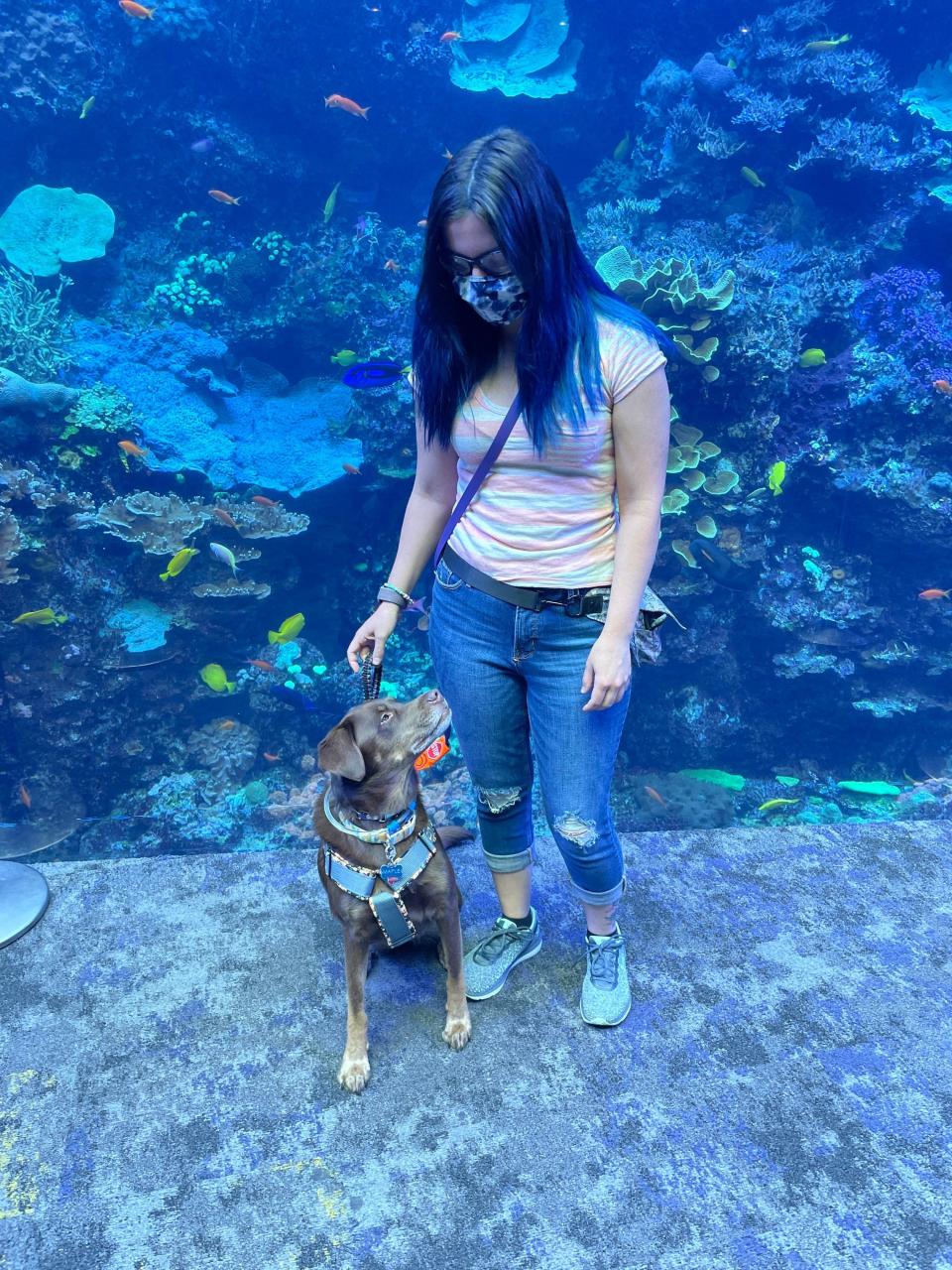
Sarah B. and Maple enjoying the aquarium together.
She also mentioned that the wait times were longer than she wanted to wait. Reputable program dogs have a two- to four-year waiting list to get one of their fully trained dogs. And not every handler wants to wait that long.
Owner training was the most affordable way to get the help she needed. And Maple was the perfect candidate. Maple was 3 years old when Sarah started working with a trainer, but Sarah had already put in thousands of hours of training, and Maple was fully public-access ready. Sarah worked with her trainer and with Maple on task training for another five to six months before Sarah started working her in public. And they also did a six-week board and train to start some of Maple’s more complicated tasks, like med retrieval.
Not All Dogs Are Cut Out to Be Service Dogs
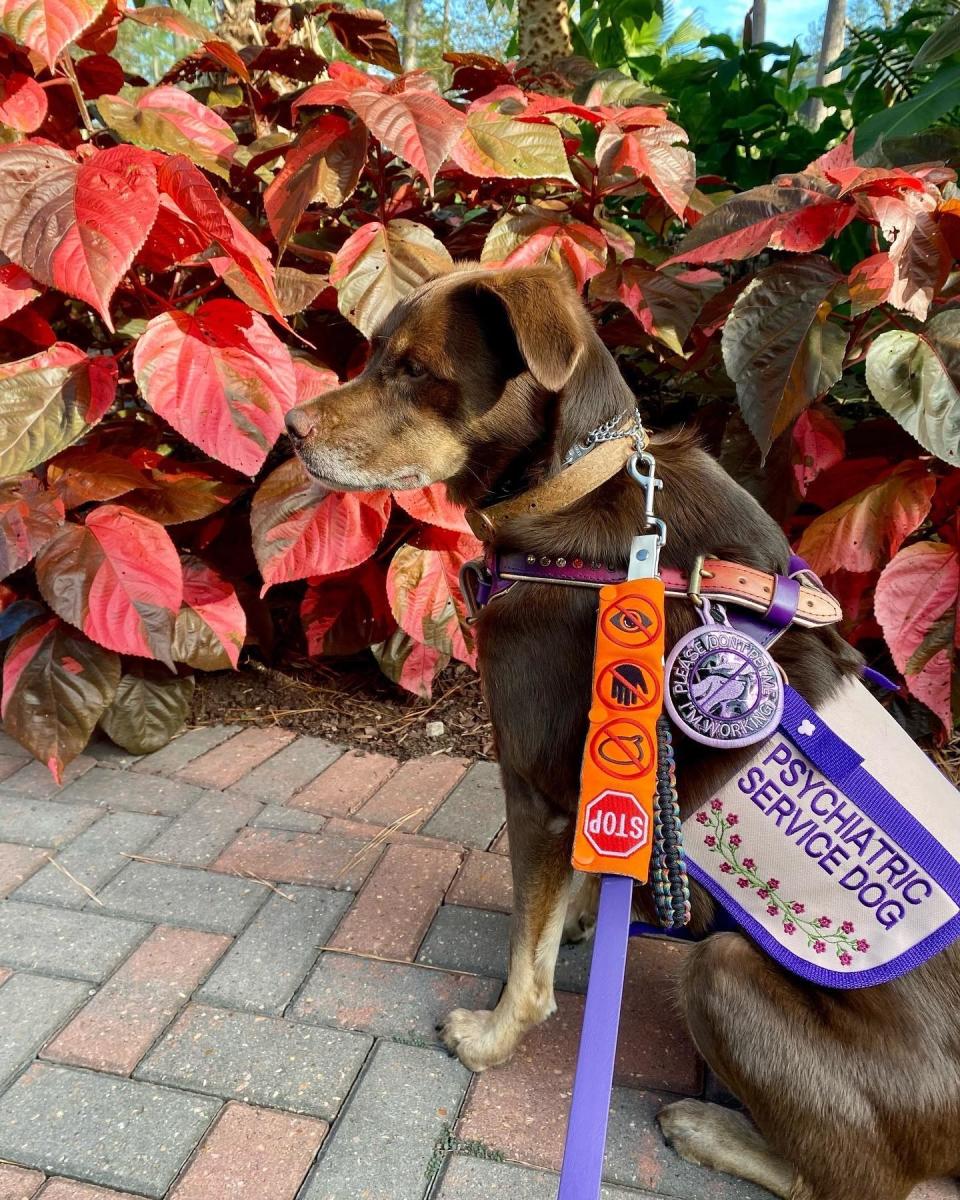
Not everyone is as lucky as I was, or as Sarah was, with their dogs. Every dog that starts being trained as a service dog has a 50% wash rate. That means that at least half of dogs who are trained to be service dogs fail.
This could happen for a variety of reasons:
• They don’t like doing their job.
• They’re too friendly.
• They’re too timid.
• They’re not a good match with their handler.
• They’re reactive.
• They don’t understand their tasks.
• They hate being in public.
And many more reasons.
While it's sad when dogs are washed, it's important to have a washing plan in case your dog doesn't fit well as a service animal. Some people, myself included, have made a lifelong commitment to the dog and would keep it as a pet. Others have worked out agreements with family members to take the animal, since they can't handle more than one dog — and needing a service dog is a priority. Finally, some handlers re-home the animal to someone who can care for the dog.
None of these options are inherently better than the other, and it's always sad to see the dog wash. But having a plan in place before you set off to find a service dog saves a lot of heartache down the road.
Certain breeds and personality traits can signal that a dog may be fit for service training.

Kimberly Borg, who’s been a trainer for over 10 years and runs Furever Pawsitive Change, has personally washed quite a few dogs in her program. And during the contract-signing portion of her business, she has a frank conversation with owners about what they would do if their dog washed.
She doesn’t steer people away from owner training because of the wash rate, though. She always recommends going with one of the four known service dog breeds — Goldens, Labs, Poodles, and Rough Collies — and buying from a reputable breeder.
“While adopt don’t shop is great for pets,” she told me, “When you’re looking for a service dog, you’re looking for a very specific temperament and want to make sure there are as few health issues as possible. Don’t get me wrong; shelter dogs have made great service dogs — my first dog was a shelter dog, but you don’t want to work a traumatized dog in a high-stress situation. It’s not fair. I highly recommend going with a reputable breeder instead. It’s worth the extra money.”
With such a high wash rate, finding the right dog is crucial to owner training success. Working with a trainer to help you pick out the puppy from a litter is instrumental if you’re able to find a trainer that does temperament testing. You can look for a dog that has low working drive, a high praise drive, and a curiosity for life. While it's important for the dog to want to work, if it's too instinctual, this can actually inhibit training.
Even Experienced Trainers Still Have Dogs Wash
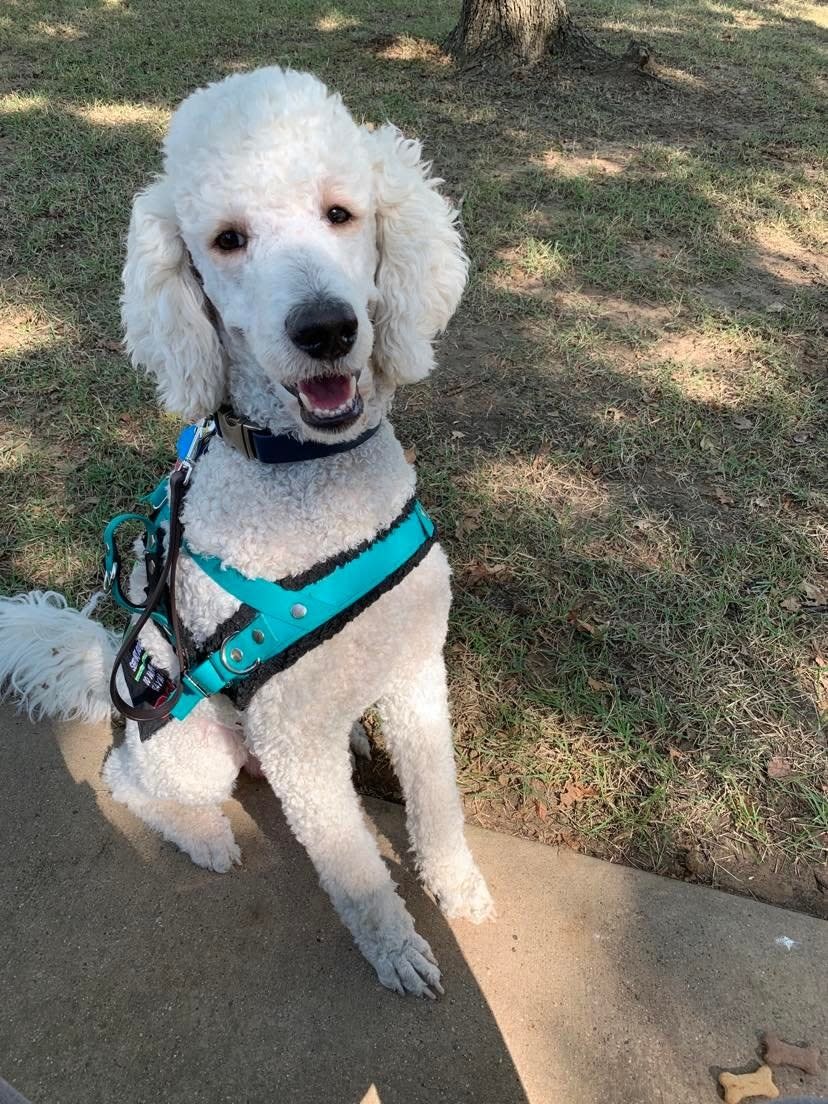
While she’s washed many of her program dogs, she’s no stranger to washing personal dogs as well. Her last service dog in training, Pippin, was washed for aggression issues that surfaced after his heartworm treatment.
“But,” Kimberly told me, “I probably would have washed him anyway because he was way too attached to my husband when we were in public.”
Pippin, her washed service dog, cost a few hundred dollars up front, and she estimates that she put in about $1,500 worth of training before she washed him. And that’s on top of the $800 they spent on his heartworm treatment and other vet bills he accrued. In total, Pippin was worth $2,500 by the time she washed him, only a few months into his training.

Kimberly's washed dog, Pippin.
Her next dog, Bellatrix, a purebred Rhodesian Ridgeback, took two years to find. Ridgebacks aren’t a common service dog because they have one of the highest wash rates, but Kimberly needed a larger dog, and Ridgebacks have been her dream dog for 15 years. She also has the knowledge and experience to handle a difficult breed, but she still recommends first-time handlers going with a dog that has a higher success rate.
At 9 months old, Bella is just starting her public access training, but is already proficient at four different tasks and works consistently as an in-home service dog. Her training will be complete in a year and a half. And the energy, money, and time put into her equates to about $20,000 — even though Kimberly paid only a fraction of that cost because she’s a trainer.
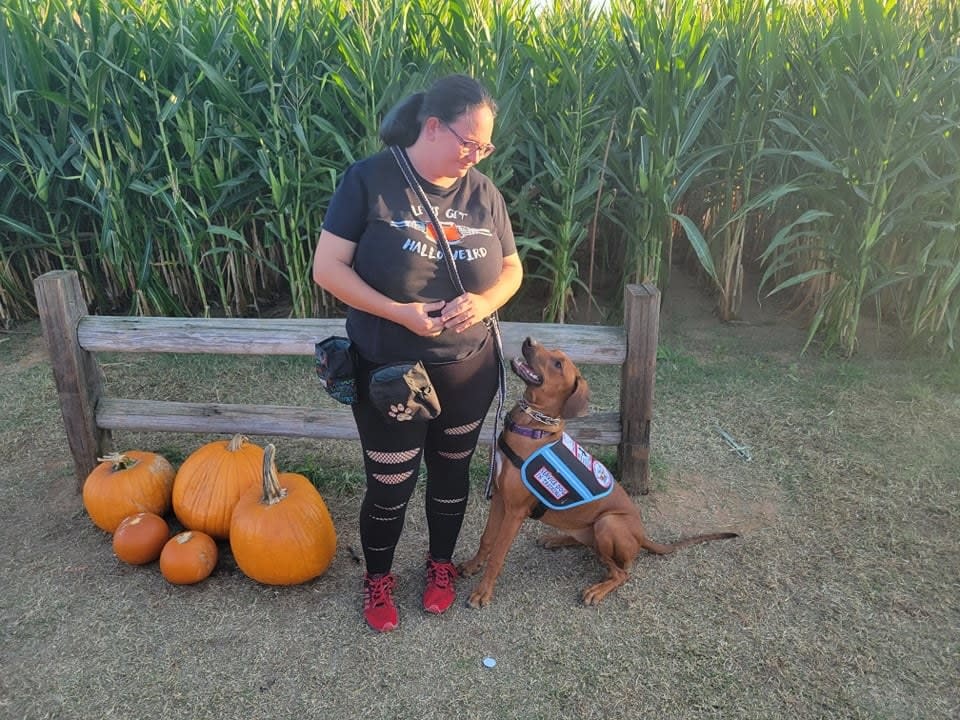
Kimberly with her current service dog in training, Bellatrix.
Your Second Dog Is a Different Journey Than Your First
Due to the nature of service dogs, your first dog typically won’t be your only dog. You either retire them because they’re old, or in Erika D.’s case, of an injury.
Erika’s first service dog, a Bichon Frise Shih Tzu mix, was the only reason she made it through college. Teddy would interrupt her disassociations during tests and help keep her focused. Unfortunately, about five years into his service, Teddy needed a $9,000 back surgery, and Erika medically retired him.
Thankfully, she carried pet insurance, so her out-of-pocket cost was only $1,200. She recommends pet insurance for all service dog handlers. Because service dogs engage with the public more, they’re more likely to need vet visits and things like that. And in Erika’s case, having insurance saved her $7,800, which is more than Teddy cost to be trained.
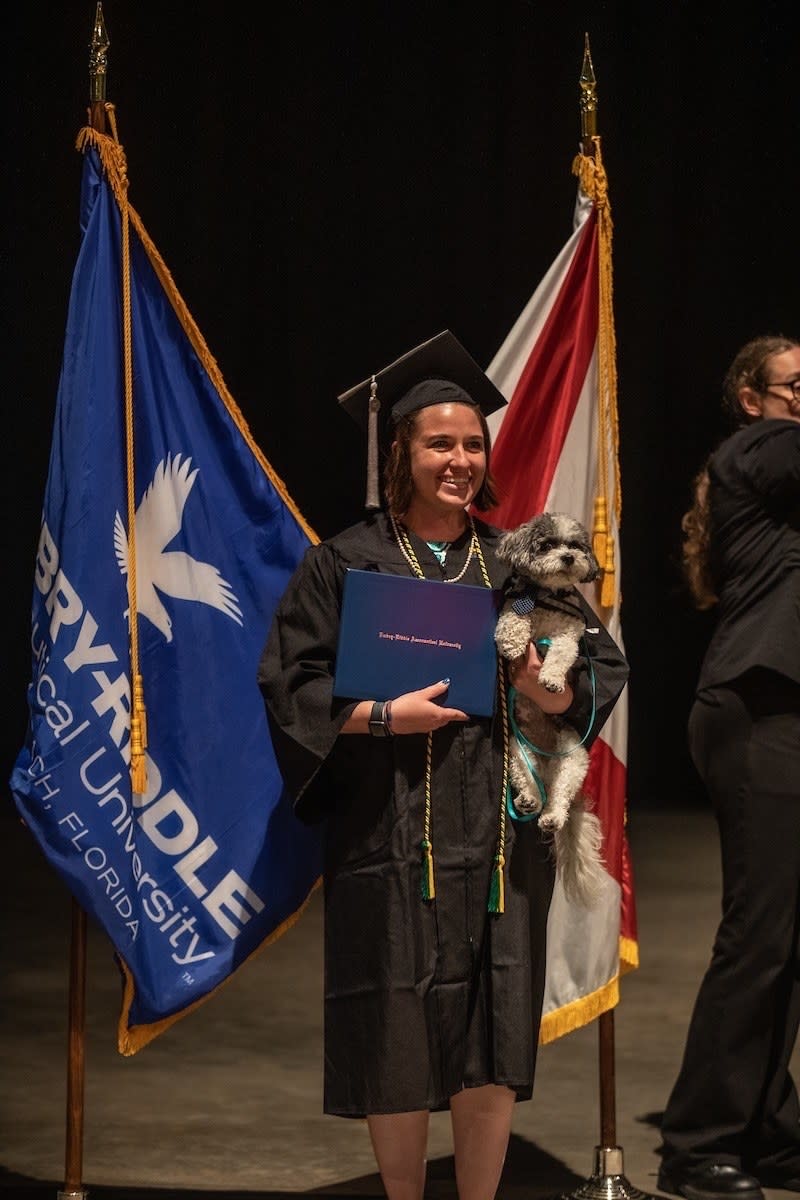
Erika graduating college with Teddy by her side.
She knew she needed her next dog to be bigger, and she wanted to go with one of the Fab Four breeds for the greatest success rate.
She found a reputable breeder who specialized in Standard Poodles and was put on a wait list. Originally, she was going to get her Poodle in August or September, but the breeder called her about a small white poodle in July. No one wanted him because of his coloring, but Erika didn’t care, took him home, and named him Appa.
Six days after coming home, Appa was playing with her Doberman Pinscher, Ovi, and Ovi scratched his eye. Pet insurance kicks in on day seven after purchasing. When she took him to the vet, the vet needed to perform a $3,000 procedure. Erika laughed, though, when recalling this story, because before he even started training, Appa cost her $4,500.
What she didn’t realize when getting her next dog was how different their journeys would be. “There was so much I didn’t expect the first time, but it’s crazy how much different it was the second time around.” she told me.
Each dog is completely different, and she was working with a different trainer as well. And since Teddy was 11 pounds and Appa is closer to 70 pounds, they don’t task the same way.
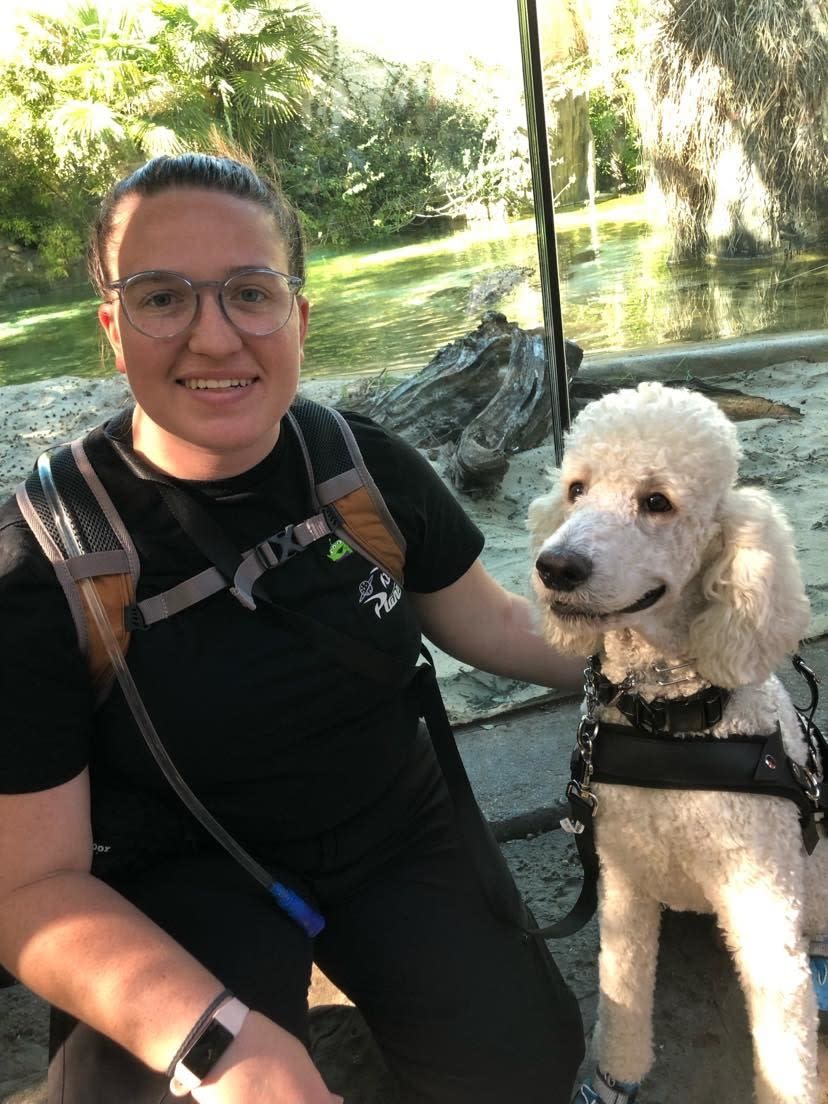
Erika and Appa enjoying a day at the zoo.
Service Dogs Are Life-Changing
You can’t expect each journey to be identical. My journey started in the middle of the night shaking as a dog licked my face. Sarah knew she wanted help, but didn’t decide to pursue service work until her dog had a solid foundation. Kimberly has been training service dogs for a decade. And Erika got her first dog with the intention of training him to be a service dog.
For all of us though, owner training was the most accessible option. None of the trainers we worked with cost more than $12,000 to fully train our dogs. While that’s a lot of money, it’s considerably cheaper than a program dog. I fully acknowledge that we’ve been lucky. Our dogs didn’t wash their programs. Owner training can be expensive if you have to wash multiple dogs, and luckily we haven’t had to do that.
Instead, we’re able to walk about our lives moderately independently, and trust that our dogs have our backs. It’s a freedom that we've fought so hard for, and that our dogs allow us to experience. And owner training allows us to take ownership in that freedom. I work consistently with my dog to teach her new tasks that mitigate my disabilities. And when she learns something, I feel like I’m on top of the world because I know that’s one more way I’m gaining freedom from my demons. We can look at our dogs, and look at our trainers, and say, “Look what we did!”
Simply put, no feeling is better to me than the feeling of fighting for freedom, even if it comes with a $12,000 price tag.
Do you have a service animal? Tell us about your journey in the comments!
And for more stories about life and money, check out the rest of our personal finance posts!

